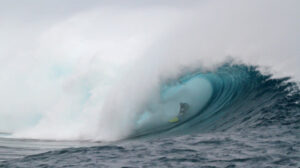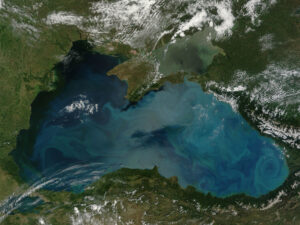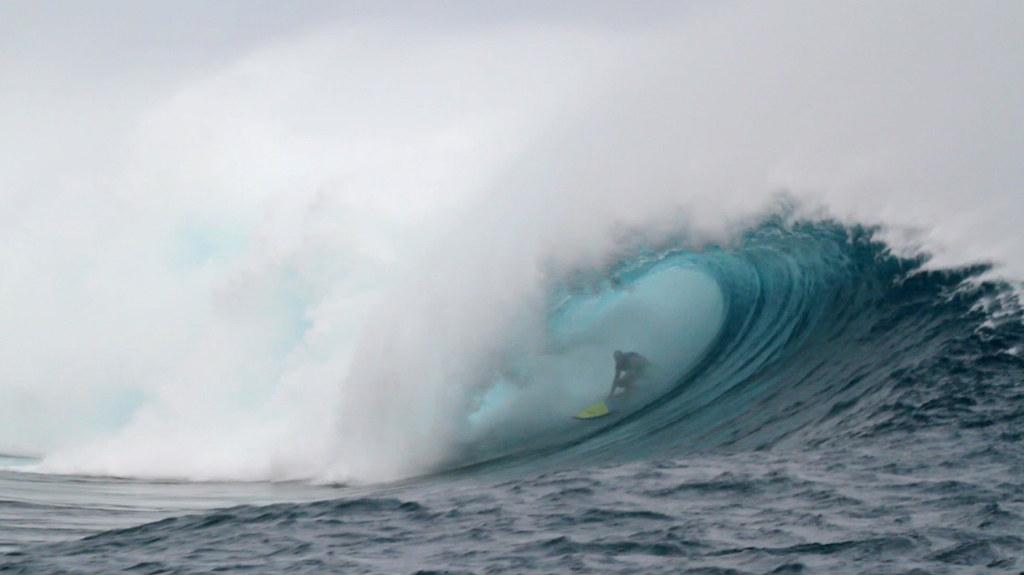References: Angle, Kyle J.; Crocker, Daniel R.; Simpson, Rebecca M. C.; Mayer, Kathryn J.; Garofalo, Lauren A.; Moore, Alexia N.; Mora Garcia, Stephanie L.; Or, Victor W.; Srinivasan, Sudarshan; Farhan, Mahum; Sauer, Jon S.; Lee, Christopher; Pothier, Matson A.; Farmer, Delphine K.; Martz, Todd R.; Bertram, Timothy H.; Cappa, Christopher D.; Prather, Kimberly A.; Grassian, Vicki H. (2021). Acidity across the interface from the ocean surface to sea spray aerosol. Proc. Natl. Acad. Sci. U.S.A. 118, e2018397118.
DOI: https://doi.org/10.1073/pnas.2018397118
Reading Time: 5 minutes

Picture the perfect wave. Surfers would picture a head-high to overhead wave barreling from a point with some offshore winds (like the picture). Minding the jargon, these types of waves crash on beaches across the globe. Every breaking wave produces a collection of particles that shoot into the air known as sea spray aerosol (SSA). These microscopic particles contain a lot of stuff, like water, salts, and dissolved organic molecules. Once ejected into the air, these particles can form clouds with its surrounding humidity. This cloud-forming process is significantly important for scientists as it directly connects the ocean and atmosphere. Furthermore, sea spray can influence how plants grow and where animals live in coastal regions. For scientists to understand our climate, sea spray is a crucial aspect. For example, sea spray particles are mostly composed of ocean water, so they have a certain acidity (pH). As the ocean acidifies (which is covered in another Oceanbites article here), we can ask the question what happens to sea spray?
A collective team of scientists from UC San Diego, UC Davis, Colorado State, and University of Wisconsin-Madison decided to investigate this question. Previous research efforts have tried to measure the pH of sea spray aerosol particles, but they have had difficulties with accuracy and precision. The group decided to simulate their own waves in a laboratory (using water from the ocean) and measure the particles there. The team refined the previous work of other groups and used pH paper (like the test strips for pools) to measure pH. Today, we are going to see what they found out.
What did they find?

The group found that sea spray aerosol particles were a million times more acidic than seawater! While the seawater had a pH around 8.1, sea spray particles from their simulated waves had pH’s close to 2. Interestingly, this process of increasing acidity happened over 2 minutes! When the particles are ejected from the water, they interact with acidic molecules in the air and their pH drops. As for more specific details, the smaller particles were more acidic than their larger counterparts. During their research, the group noticed that the pH of sea spray particles could be affected by the contents of water in their system. They discovered that water with a lot of biological organisms (like phytoplankton) have a lot more complexity for its pH versus water with less. Even with this information, the scientists could not conclude a strong connection between one biological aspect of water and sea spray pH. The group found that the concentration of carbon dioxide in the surrounding air was far more indicative of sea spray pH. The team states that external factors like dust and the chemical ammonia in the air can interact with sea spray, making the particles less acidic.
The collective elicits the importance of these findings in relation to the chemical sulfur dioxide. This chemical can be transformed into sulfate, an important molecule for trapping heat in the atmosphere, when it reacts with oxygen (O2) in sea spray aerosols. Through their research, the group found that this process occurs significantly less than what we previously thought. So, scientists will have to account for this change when we try to model and understand our climate in the future.
Why does it matter?
This investigation tells us a lot about sea spray particles. They perform a plethora of activities like forming clouds, catalyzing chemical reactions, and even impacting human lung health! With this knowledge we can better understand how coastal regions are impacted by sea spray and model how our climate functions. All this information helps us comprehend the larger impacts of ocean acidification both now and beyond.
Hey! I’m a PhD student at the University of California, Davis studying biophysics. I previously studied organic chemistry (B.S.) at the College of William and Mary. Currently, I investigate the physical responses of lipid membranes to their environmental stimuli and explore the mechanistic potential of the protein reflectin, from D. opalescens, in soft matter systems. Generally, I am interested in how biological systems respond to physical stressors across all size scales, no matter how big or small! I am driven to pursue a career in science communication and outreach, especially in translating research findings into actionable, grassroots reform. Outside of school, I surf the Norcal coastline, play ultimate frisbee, and read.


Family summer surf camps are a great way to get out of a rut and start creating a routine together as a family in which everyone thrives.